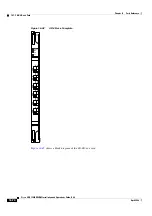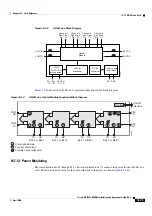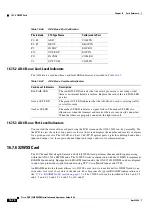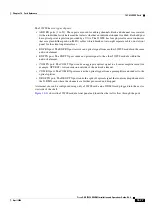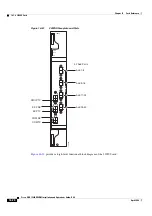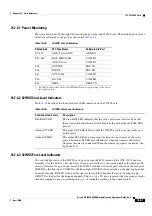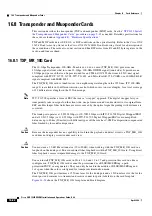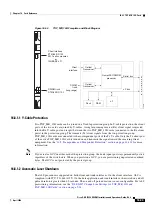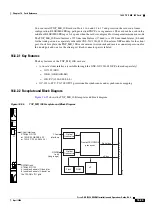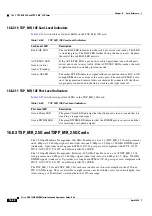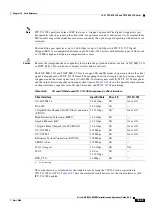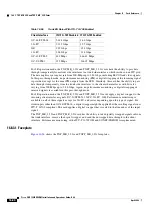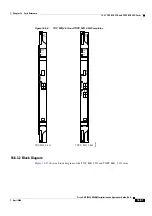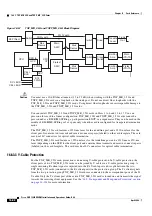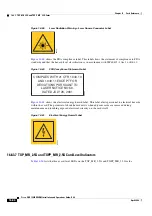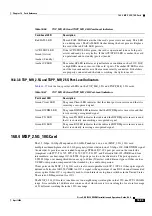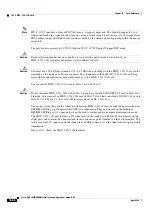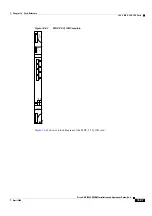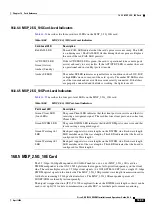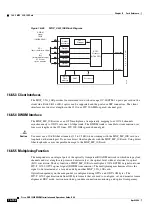
16-87
Cisco ONS 15454 DWDM Installation and Operations Guide, R6.0
April 2006
Chapter 16 Card Reference
16.8.2 TXP_MR_10E Card
Note
If you create a GCC using a digital wrapper and apply it to either card of the Y-cable protect group, the
DWDM trunk (span) port stays permanently active, regardless of the switch’s state. When you provision
a GCC, you are provisioning unprotected overhead (OH) bytes. The GCC is not protected by the
protection group.
16.8.2.6 Enhanced FEC (E-FEC) Feature
A key feature of the TXP_MR_10E is the availability to configure the forward error correction in three
modes: NO FEC, FEC, and E-FEC. The output bit rate is always 10.7092 Gbps as defined in
ITU-T G.709, but the error coding performance can be provisioned as follows:
•
NO FEC—No forward error correction
•
FEC—Standard ITU-T G.975 Reed-Solomon algorithm
•
E-FEC—Standard ITU-T G.975.1 algorithm, which is a super FEC code.
16.8.2.7 FEC and E-FEC Modes
As client side traffic passes through the TXP_MR_10E card, it can be digitally wrapped using FEC
mode, E-FEC mode, or no error correction at all. The FEC mode setting provides a lower level of error
detection and correction than the E-FEC mode setting of the card. As a result, using E-FEC mode allows
higher sensitivity (lower OSNR) with a lower bit error rate than FEC mode. E-FEC enables longer
distance trunk-side transmission than with FEC.
The E-FEC feature is one of three basic modes of FEC operation. FEC can be turned off, FEC can be
turned on, or E-FEC can be turned on to provide greater range and lower BER. The default mode is FEC
on and E-FEC off. E-FEC is provisioned using CTC.
Caution
Because the transponder has no visibility into the data payload and detect circuits, the TXP_MR_10E
card does not display circuits under the card view.
16.8.2.8 Client-to-Trunk Mapping
The TXP_MR_10E card can perform ODU2-to-OCh mapping, which allows operators to provision data
payloads in a standard way across 10-Gbps optical links.
Digital wrappers that define client side interfaces are called Optical Data Channel Unit 2 (ODU2)
entities in ITU-T G.709. Digital wrappers that define trunk side interfaces are called Optical Channels
(OCh) in ITU-T G.709. ODU2 digital wrappers can include Generalized Multiprotocol Label Switching
(G-MPLS) signaling extensions to ITU-T G.709 (such as Least Significant Part [LSP] and Generalized
Payload Identifier [G-PID] values) to define client interfaces and payload protocols.
16.8.2.9 Automatic Laser Shutdown
The ALS procedure is supported on both client and trunk interfaces. On the client interface, ALS is
compliant with ITU-T G.664 (6/99). On the data application and trunk interface, the switch on and off
pulse duration is greater than 60 seconds. The on and off pulse duration is user-configurable. For ALS
provisioning information, see the
“DLP-G217 Change Line Settings for TXP_MR_10G and
Содержание ONS 15454 DWDM
Страница 38: ...Figures xxxviii Cisco ONS 15454 DWDM Installation and Operations Guide R6 0 August 2005 ...
Страница 54: ...Procedures liv Cisco ONS 15454 DWDM Installation and Operations Guide R6 0 August 2005 ...
Страница 64: ... 64 Cisco ONS 15454 DWDM Installation and Operations Guide R6 0 August 2005 Chapter ...


